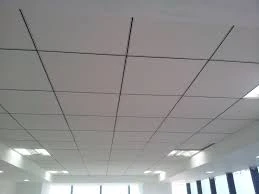Dec . 14, 2024 04:57 Back to list
pvc ceiling vs gypsum
PVC Ceiling vs. Gypsum A Comprehensive Comparison
When it comes to interior design and construction, ceiling materials play a crucial role in not just the aesthetics of a space but also its functionality and durability. Among the popular choices available in the market today, PVC (Polyvinyl Chloride) ceilings and gypsum ceilings are two of the contenders that often come up in discussions. This article aims to explore the key features, benefits, and downsides of each material, helping you make an informed choice for your next project.
Material Composition and Construction
PVC ceilings are made from a type of plastic, which is lightweight and flexible. These panels typically come in various designs, colors, and textures, making them a versatile option for any interior. PVC is inherently resistant to moisture, making it an excellent choice for areas like bathrooms and kitchens where humidity levels can fluctuate dramatically.
On the other hand, gypsum ceilings are usually made from gypsum board or drywall, which is heavier and less flexible than PVC. Gypsum is a mineral that offers great fire resistance and sound insulation properties. It is often used for creating flat, seamless surfaces that can be painted or finished in multiple ways. However, gypsum ceilings are more susceptible to moisture damage, which can lead to issues like sagging or mold growth if not properly sealed or maintained.
Aesthetic Appeal
One of the primary considerations when selecting a ceiling material is aesthetics. PVC ceilings are available in a plethora of styles, including glossy finishes, wood-like textures, and intricate patterns that can mimic the look of traditional ceiling tiles. This variety allows homeowners and designers to achieve a specific look without extensive remodeling.
Gypsum ceilings, particularly when finished with paints or decorative moldings, can create a more sophisticated and classic appearance. They are often used in commercial settings and luxury homes where a polished, elegant look is desired. However, the customization options are somewhat limited compared to the endless variations and modern designs available with PVC.
Installation Process
pvc ceiling vs gypsum

Installation is a vital factor to consider when comparing PVC and gypsum ceilings. PVC panels are generally easier and quicker to install. Their lightweight nature means they can often be installed directly onto existing ceilings, minimizing additional framing or support. Most DIY enthusiasts can tackle PVC installation with relative ease.
In contrast, gypsum ceilings require more extensive labor and expertise. They need a skeleton framework to support the heavy boards, and the installation process can be more time-consuming. Additionally, once installed, gypsum ceilings typically require finishing work such as sanding and painting, which adds to the overall time and cost.
Durability and Maintenance
Durability is an essential aspect of any building material. PVC ceilings are resistant to moisture, mold, and mildew, making them suitable for areas prone to dampness. They are also non-corrosive and do not chip or crack easily, leading to lower maintenance costs over time. Cleaning is also a breeze since PVC can simply be wiped down with a damp cloth.
Gypsum ceilings, while durable under normal conditions, can be affected by moisture. In areas with high humidity, they can sag or develop mold if not treated correctly. They may require periodic maintenance to ensure their integrity and cleanliness, such as repainting or patching.
Cost Considerations
When it comes to cost, PVC ceilings generally have a lower initial investment when factoring in both material and installation costs. The ease of installation can significantly reduce labor expenses. In contrast, gypsum ceilings can be more expensive due to their heavier material, need for framing, and specialized installation requirements.
Conclusion
In conclusion, both PVC and gypsum ceilings have their unique advantages and disadvantages, making them suitable for different applications and preferences. PVC ceilings offer a lightweight, cost-effective, and moisture-resistant option, ideal for modern and functional interiors. Gypsum ceilings, on the other hand, provide a timeless, elegant finish but require more effort and care to maintain. Ultimately, the choice between PVC and gypsum will depend on your specific needs, aesthetic preferences, and budget constraints. Whatever your selection, both materials can enhance the visual appeal and functionality of your space.
-
Quality Ceiling Trap Doors & Access Panels | Easy & Secure AccessNewsAug.30,2025
-
Durable Ceiling T Grid Systems | Easy InstallationNewsAug.29,2025
-
PVC Gypsum Ceiling: Durable, Laminated Tiles for Modern SpacesNewsAug.28,2025
-
Pvc Gypsum Ceiling Is DurableNewsAug.21,2025
-
Mineral Fiber Board Is DurableNewsAug.21,2025
-
Ceiling Tile Clip Reusable DesignNewsAug.21,2025







